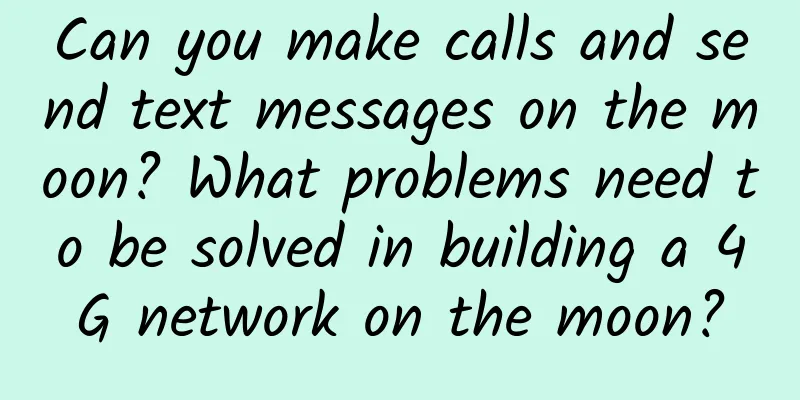Can you make calls and send text messages on the moon? What problems need to be solved in building a 4G network on the moon?

|
Recently, Nokia publicly demonstrated for the first time the prototype equipment of its first 4G communication network to be deployed on the moon. According to the plan, the company will use SpaceX's rocket to bring the 4G network to the lunar surface for experimental communication at the end of 2023, with the aim of laying the foundation for humans to better explore the moon and Mars. So, what are the characteristics of building a 4G network on the moon? Nokia's Bell Labs released a schematic diagram of the lunar 4G network communication Meeting the needs of future lunar bases In October 2020, NASA announced that it had partnered with Nokia and awarded the company a $14.1 million contract to build a 4G cellular communications network that can be used on the moon. The lunar 4G network is part of NASA's critical point selection project, which aims to meet NASA's needs for building a lunar base. In the 1960s, NASA's Apollo program successfully sent astronauts to the surface of the moon. Now, there are many deep space probes that rely on NASA's Deep Space Network for communications. So why does NASA still want to build a 4G network on the moon? At present, although the United States has more than 20 deep space probes operating in space, they are far apart and there is little need for communication between them. In 2017, the United States announced its return to the moon, which is the moon landing plan officially named "Artemis" in 2020. The United States will not only carry out large-scale lunar exploration missions, but also build a permanent lunar base and deploy many landers, lunar rovers and other equipment. These lunar probes are distributed around the lunar base and are not far from each other. If these probes communicate with the Deep Space Network independently, it will not only increase the burden on the Deep Space Network, but also carry a communication payload that can contact the earth. The overall architecture is not only unreasonable, but also not conducive to communication. Therefore, for the Artemis plan, the reasonable choice is to set up a wireless network and connect various probes on the lunar base to the network for communication. However, NASA's approach is not new. Wireless WiFi has long been installed on the International Space Station, and the core module and experimental module of China's Tiangong Space Station are also equipped with WiFi systems to facilitate astronauts' in-cabin communications. Due to the small size of the space station, the experimental WiFi system with a short communication distance can meet the needs. However, the lunar base built by humans in the future will be very large, and the distance between probes can reach several kilometers, so long-distance communication technologies such as 4G must be used. Some people may ask, why not just use the more advanced 5G? Although NASA signed a contract with Nokia in 2020, Nokia began developing a lunar wireless network in 2018. At that time, 5G networks were not mature enough. The technical span and risk of using the lunar + 5G network in one step were too large, and the advantages of 5G networks such as large bandwidth could not be brought into play. For the sake of safety, they had to choose to develop a lunar 4G network. To withstand the test of the environment In recent years, although 5G networks have been in the limelight, the networks used on the ground are still mainly 4G. So, what is the difference between the 4G network used on the moon and the 4G network we usually use, and what issues should we pay attention to? According to a statement from Nokia, the company's Bell Labs is responsible for the construction of the lunar 4G network. If we only look at the realization of the communication part, the lunar 4G network is actually to move the mature and reliable 4G network on the ground to the moon, but due to the harsh environment on the lunar surface and the test of the probe launch and landing process, the lunar 4G network will be an ultra-compact, space-reinforced and low-power solution. Specifically, Nokia's lunar 4G network will be integrated into the Nova-C small lander developed by Intuitive Machines, which includes a set of 4G base stations and 4G communication terminals with core network functions. Nokia said that the 4G network launched to the lunar surface has been specially designed to meet the size, weight and power limitations of the Nova-C lander. At the same time, the communication network is also capable of withstanding the harsh conditions of rocket launches, cis-moon flights, lunar landings and the lunar surface, and can operate stably under various extremely harsh conditions. In order to be deployed on the lunar surface and provide communication coverage, lunar 4G base stations must reduce size, weight and power consumption as much as possible. For example, the Nova-C lander can only carry 100 kilograms of payload to the lunar surface, and the total power provided is only 200 watts. The lunar 4G base station on the lander must not only withstand the acceleration, impact and vibration during rocket launch, but also the extreme temperature difference in space. Since there is no air on the lunar surface, the air cooling and other heat dissipation solutions of the ground 4G base station cannot be used. Therefore, the lunar 4G base station must integrate a special radiation heat dissipation system through radiation cooling. Considering that the daytime temperature on the lunar surface exceeds 120 degrees Celsius and the daytime lasts for about half a month, if the lunar 4G base station does not use special materials, the heat dissipation system will hardly withstand the high temperature test on the lunar surface. In short, if the lunar 4G network is to work in the extremely harsh lunar surface, it must adopt a special design. Therefore, how to cope with the challenges of the lunar environment is the biggest difference between the construction of the lunar 4G network and the terrestrial 4G network. Helping future deep space exploration Today, 4G base station technology on Earth is very mature, but the practical 4G network on the moon still faces many difficulties and challenges. Nokia has carried out a lot of research and development work and simulation tests to develop the lunar 4G network. For example, the prototype base station was placed on a centrifuge and a vibration table to simulate acceleration and vibration; in order to reduce the weight of the base station, the filter also used new ceramic materials; the temperature difference between the sun-facing and dark-facing sides of the moon is more than 100 degrees Celsius, and the base station antenna has also been specially strengthened; the base station not only takes special heat dissipation measures, but also optimizes the control software for the lunar environment. Although there are many challenges in building a 4G network on the moon, Nokia has basically completed the research and development of lunar 4G network technology, and its equipment will be sent to the moon on the IM-2 mission at the end of this year. The Nova-C lander of the IM-2 mission will land near Shackleton Mountain at the south pole of the moon. It carries a lunar rover dedicated to verifying the 4G network and will conduct 4G network testing tasks during the lunar day. According to the plan, after the Nova-C lander lands on the moon, it will release the lunar rover and start the 4G network to establish two-way real-time communication between the two. The lunar rover will send real-time video data to the base station of the lander through the 4G network link, first testing short-distance communication of 100 meters, and then the lunar rover will gradually move farther to increase the distance and test long-distance communication of 2 to 3 kilometers. Nokia said that the lunar 4G base station developed by the company can support communication up to 5 kilometers away. If Nokia's lunar 4G network test is successful, it means the feasibility of directly transplanting commercial mature off-the-shelf technologies on the moon, which will be of great significance to human deep space exploration. In addition, the lunar 4G network can support real-time communication between the lander, lunar rover, living module and astronauts, and realize remote control of the lunar rover and other exploration equipment through real-time video. The test of the lunar 4G network will fully prepare the communication system for the lunar base of the "Artemis" program. With the development of communication technology, the lunar 4G network will also be further upgraded or updated to a 5G network, making more contributions to human lunar exploration and more distant scientific missions to Mars. (Author: Zhang Xuesong) |
<<: The subtle ideas of physics may lie in a simple picture
>>: Random talk: "Zheli" scientist - Tan Jiazhen: "Father of Chinese genetics"
Recommend
Let me give you an example of the pitfalls I encountered when making event products (data review)
Let’s review the activity process first: 1. Total...
The mysterious archaea discovered by accident can "revive" old oil fields
Methanogens are a type of bacteria that use metha...
Let’s talk about the “unspoken rules” that must be understood and faced in community operations work!
There are three forms of rules: explicit rules, i...
Tesla: Tesla's car production in Q1 2022 was 305,400 and 310,000 were delivered
Tesla has just announced its car production and d...
[Case] How did her community achieve 40 million users in a year?
In the past six months, many mobile community app...
Tesla Motors Are Not Disruptive Products
When I was reading The Innovator's Dilemma, t...
A famous actress died of "influenza complicated with pneumonia"! Don't delay catching a cold if you have these symptoms...
According to The Paper, Taiwanese actress, singer...
Why does a fever come back a few days after it subsided? Doctors remind you!
Recently, many people have gradually recovered, b...
Scientists, come on, protect our Xinjiang cotton!
Author: Bug Squad The article comes from the Scie...
Full of useful tips on home fire prevention: This is what a fire extinguisher looks like!
Your browser does not support the video tag What ...
Can quitting sugar make us more beautiful and younger?
Recently, the news that "a woman became whit...
Xiaomi Tablet's Strongest Rival is Not iPad
On May 15, Xiaomi held a new product launch confer...
How to play the second type of e-commerce information flow advertising!
When the Internet becomes a traditional industry,...
Did Bai Juyi also suffer from depression? Is it the same as what we are talking about today?
Therefore, the verses written on the river bridge...
How much does it cost to invest in Haikou’s automatic ordering app?
How much does it cost to attract investment in th...









